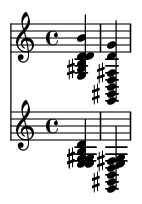Unravel the mystery behind one of rock's most iconic sounds. From its jazz origins to its explosive impact in the hands of Jimi Hendrix, we'll explore the theory, application, and enduring legacy of the dominant 7#9 chord.
Introduction
When you hear the opening crunch of "Purple Haze" or the swaggering riff of "Foxy Lady," you're hearing more than just a chord; you're hearing a revolution. The dominant 7#9 chord, now inseparable from the name Jimi Hendrix, injected a potent cocktail of blues ambiguity and jazz sophistication into the raw energy of rock music. It’s a sound that is simultaneously aggressive and soulful, a harmonic clash that perfectly captures the spirit of an era.
Definition and Structure
Technically known as a dominant seventh sharp ninth chord, the "Hendrix Chord" is a five-note chord built on the fifth degree of the major or minor scale. Its unique tension comes from containing both a major third and a sharp ninth, which is enharmonically equivalent to a minor third.
The intervals from the root are:
- Root (1)
- Major Third (3)
- Perfect Fifth (5)
- Minor Seventh (b7)
- Sharp Ninth (#9)
Let's build an E7#9, the chord from "Purple Haze":
- E (Root)
- G# (Major Third)
- B (Perfect Fifth - often omitted on guitar)
- D (Minor Seventh)
- F## (Sharp Ninth). On the keyboard and guitar, this is played as a G natural. This G natural clashes beautifully with the G# major third, creating the chord's signature "bluesy" dissonance.
A Brief History: Before Hendrix
While Hendrix immortalized the 7#9 in rock, he didn't invent it. The chord was a staple in the vocabulary of jazz musicians long before it hit the mainstream. Jazz pianists and composers like Thelonious Monk and Horace Silver used its dissonant quality for harmonic color and tension. Its roots can be traced even further back, with some hearing its essence in the work of early 20th-century composers. Hendrix's genius was in taking this piece of jazz harmony, plugging it into a Marshall stack, and making it the cornerstone of his revolutionary sound.
Example 1: Building the Chord
This example shows a standard E7 chord in the first measure, followed by the E7#9 in the second measure. Notice the addition of the G natural on top, which creates the #9 tension against the G# in the bass clef.

Iconic Guitar Voicings
Part of the chord's fame is due to how perfectly it sits on the guitar fretboard. The common voicings are compact, powerful, and relatively easy to grab. The fifth of the chord (B in an E7#9) is almost always omitted to make the voicing more comfortable and to avoid cluttering the sound.
The "Purple Haze" Voicing (Moveable Shape)
This is the most famous voicing, used for E7#9 in "Purple Haze." You can move this shape anywhere on the neck. The 'x' means mute the string.
- Fretboard: x7678x (from low E to high e string)
- E String (6th): Muted
- A String (5th): 7th fret (E - Root)
- D String (4th): 6th fret (G# - Major 3rd)
- G String (3rd): 7th fret (D - Minor 7th)
- B String (2nd): 8th fret (G - Sharp 9th)
- e String (1st): Muted
The Open Position Voicing
This version gives a bigger, more ringing sound by using the open low E string.
- Fretboard: 07678x
- E String (6th): 0 (E - Root)
- The rest of the fingering is the same as the moveable shape.
The "Blues Power" Theory
The magic of the 7#9 chord is its connection to the blues. The blues scale often features a "blue note," which is a variable pitch between the minor and major third. The 7#9 chord is a perfect harmonic snapshot of this melodic ambiguity.
- Major/Minor Duality: It contains both the major third (G# in E7#9) and the sharp ninth (G natural, enharmonically a minor third). This creates a powerful internal conflict that defines the blues sound.
- Altered Dominant Function: As a dominant chord, its job is to create tension that resolves to the tonic (the "I" chord). For example, an E7#9 strongly wants to resolve to an A major or A minor chord. The added dissonance of the #9 makes this pull even stronger.
- Harmonic Condensation: You can think of the chord as condensing the entire feeling of a blues scale into a single harmonic event, delivering maximum impact in one strum.
Where to Use the Hendrix Chord
While it shines in blues and rock, the 7#9 is incredibly versatile. Here's where it works best:
- The V Chord in a Blues Progression: Its most common use. In a 12-bar blues in A, the E7 chord is the V. Using an E7#9 instead adds significant grit and tension before returning to A.
- Funk and R&B Vamps: The percussive, biting quality of the 7#9 is perfect for funk rhythm guitar, as heard in countless songs by James Brown, Parliament-Funkadelic, and Prince ("Kiss").
- Jazz and Fusion: In jazz, it's used as an altered dominant to add color and complexity to progressions, often resolving in sophisticated ways.
- Turnarounds: Use it at the end of a phrase to create a "turnaround" that leads back to the beginning of the progression.
How to Practice the Hendrix Chord
- Master the Shape: Practice fretting the moveable voicing (x7678x) cleanly. Ensure only the intended strings ring out. Slide the shape up and down the neck, naming the root of the chord at each position.
- Apply in a 12-Bar Blues: Take a standard 12-bar blues in A (chords are A7, D7, E7). Replace every dominant 7th chord with its 7#9 counterpart (A7#9, D7#9, E7#9). This will immediately train your ears and hands to use it in context.
- Listen and Identify: Put on "Purple Haze," "Foxy Lady," or Steely Dan's "Green Earrings." Listen for the chord and try to identify when it's being used. Aural training is key to understanding its function.
Famous Uses
The chord's influence is vast. Here are a few essential tracks where it plays a starring role:
- "Purple Haze" & "Foxy Lady" by The Jimi Hendrix Experience
- "Taxman" by The Beatles (the D7#9 in the solo)
- "Green Earrings" by Steely Dan
- "Kiss" by Prince
- Used extensively in the work of Stevie Ray Vaughan
Conclusion
The Hendrix Chord is more than just a collection of notes; it's a piece of music history. It represents a perfect bridge between the emotional directness of the blues and the harmonic curiosity of jazz, all packaged with the raw power of rock and roll. By mastering its structure, sound, and application, you gain a powerful tool for adding tension, expression, and a touch of rebellious attitude to your own music.
References
Shapiro, H. & Glebbeek, C. (1995). Jimi Hendrix: Electric Gypsy. St. Martin's Press.
van der Bliek, R. (2007). The Hendrix Chord: Blues, Flexible Pitch Relationships, and Self-standing Harmony. Popular Music, 26(2), 343-364.
Everett, W. (2004). Making Sense of Rock's Tonal Systems. Music Theory Online, 10(4).
